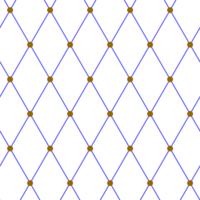Rhombus

In geometry, a rhombus (from Ancient Greek ῥόμβος - rhombos, “rhombus, spinning top”), (plural rhombi or rhombuses) or rhomb (plural rhombs) is an equilateral parallelogram. In other words, it is a four-sided polygon in which every side has the same length.
The rhombus is often casually called a diamond, after the diamonds suit in playing cards, or a lozenge, because those shapes are rhombi, although rhombi are not necessarily diamonds or lozenges.
A rhombus is a variety of quadrilateral. A rectangular rhombus is known as a square.
Contents |
Area
The area of any rhombus is the product of the lengths of its diagonals divided by two:

Because the rhombus is a parallelogram, the area also equals the length of a side (B) multiplied by the perpendicular distance between two opposite sides(H)

The area also equals the square of the side multiplied by the sine of any of the exterior angles:

where a is the length of the side and  is the angle between two sides.
is the angle between two sides.
A proof that the diagonals are perpendicular
One of the five 2D lattice types is the rhombic lattice, also called centered rectangular lattice.
If A, B, C and D were the vertices of the rhombus, named in agreement with the figure (higher on this page). Using  to represent the vector from A to B, one notices that
to represent the vector from A to B, one notices that

 .
.
The last equality comes from the parallelism of CD and AB. Taking the inner product,
since the norms of AB and BC are equal and since the inner product is bilinear and symmetric. The inner product of the diagonals is zero if and only if they are perpendicular.
Tilings
 Rhombic tiling |
This is also a called Tessellation.
Origin
The word rhombus is from the Greek word for something that spins. Euclid used ρόμβος (rhombos), from the verb ρέμβω (rhembo), meaning "to turn round and round".[1][2] Archimedes used the term "solid rhombus" for two right circular cones sharing a common base.[3]
References
External links
- Parallelogram and Rhombus - Animated course (Construction, Circumference, Area)
- Rhombus definition. Math Open Reference With interactive applet.
- Rhombus area. Math Open Reference Shows three different ways to compute the area of a rhombus, with interactive applet.


